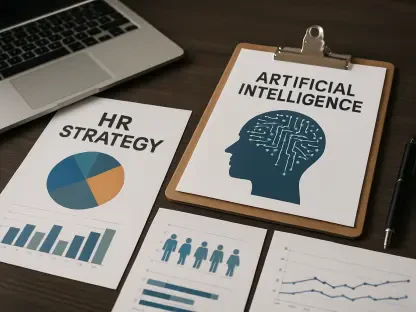The COVID-19 pandemic has drastically transformed talent strategies and workforce management. HR executives are now tasked with navigating this evolving landscape, necessitating a strategic approach to future-proof their workforce. Drawing from Deel’s Global Hiring Report, this article outlines a comprehensive blueprint for building a resilient and adaptable workforce.
Emerging Trends in Workforce Management
Gen Z’s Role in Redefining the Workforce
In 2024, Gen Z employees experienced the fastest salary growth of 9%, accompanied by the lowest rate of involuntary terminations, demonstrating their resilience and demand in the job market. Their digital proficiency and strong drive for continuous learning make them critical in modernizing the workforce. These attributes are compelling organizations to adjust traditional HR practices and create an environment that aligns with Gen Z’s expectations for technology-driven workplaces and progressive career development opportunities.
This generation’s entry into the workforce is more than just an increase in numbers; it’s about reshaping the professional landscape through innovation and a keen understanding of technology. Companies must now integrate cutting-edge tools and flexible learning opportunities to retain these dynamic individuals. By embracing a technology-centric approach and fostering continuous growth, HR leaders can ensure they capitalize on Gen Z’s potential, building a workforce that keeps pace with technological advancements and industry demands.
Increased Focus on Domestic Talent
Despite the widespread adoption of remote work, domestic hiring witnessed a significant surge of 104% in 2024 compared to a 42% increase in cross-border hires. This trend emphasizes the operational benefits of proximity while balancing global talent with local expertise. Companies are finding that while remote work opens up a vast talent pool, there’s still a strategic advantage in hiring domestically, particularly in terms of collaboration and compliance with local regulations.
Striking the right balance between remote and domestic talent is crucial for organizations aiming to optimize their workforce. Remote employees provide flexibility and diverse perspectives, but localized teams can enhance collaboration and cultural cohesion. HR leaders need to strategically blend these two facets, creating a hybrid model that takes advantage of the best both worlds offer. This approach ensures that businesses remain agile and competitive, capable of adapting to both global and local market conditions.
Demand for Specialized Roles and Stability
The Growing Importance of Accountants
The demand for accountants grew by an impressive 74% in 2024, with their salaries increasing by 15%, surpassing some traditionally competitive tech roles. This surge is driven by global expansion and the complex compliance needs that have placed accountants at the forefront of essential roles within organizations. Accountants’ expertise is now critical for navigating the intricate financial regulations of different regions, ensuring that businesses remain compliant and financially sound.
Organizations must recognize and invest in these high-demand roles by offering competitive compensation packages and growth opportunities. Accountants are no longer seen merely as number crunchers but as strategic advisors who play a pivotal role in guiding company decisions. By investing in these specialized roles, businesses can maintain a competitive edge, ensuring they are well-prepared to handle any regulatory and financial challenges that arise in an ever-evolving global market.
Emphasis on Long-Term Workforce Stability
Termination rates have seen a decline, and voluntary quits have dropped from 3% to 2% over the past two years. This trend highlights employees’ growing prioritization of stability in an uncertain economic climate. Recognizing this, HR leaders need to focus on strategies that promote long-term engagement and retention. By creating an environment where employees feel secure and valued, companies can reduce turnover rates and build a more stable and committed workforce.
Fostering long-term engagement involves investing in employee development, offering career advancement opportunities, and maintaining transparent communication. Companies that prioritize these elements can build a loyal and motivated workforce. Moreover, understanding employees’ needs and expectations helps organizations tailor their approaches, ensuring that they meet the unique demands of their workers. This dedication to workforce stability is crucial for sustaining high performance and retaining top talent in a competitive job market.
Strategic Imperatives for Future-Proofing
Embracing a Hybrid Talent Model
Organizations should create workforce strategies that blend global and local talent. While remote workers and digital nomads provide flexibility and fresh perspectives, localized teams enhance collaboration and cultural cohesion. The goal is to achieve a harmonious balance between these elements to ensure operational success and sustained growth in an increasingly dynamic business environment.
A hybrid talent model not only maximizes resource utilization but also fosters a diverse and inclusive work culture. Companies can tap into a global talent pool for specialized skills while relying on local employees for tasks that require a physical presence or intimate knowledge of regional markets. This strategic blend allows businesses to be adaptable, responsive to market changes, and culturally in tune with both their local and international team members.
Investing in Technology and Continuous Learning
Gen Z’s digital fluency has set new industry benchmarks, compelling organizations to invest in technology platforms that support remote work, data analytics, and AI-driven talent management. In addition to incorporating advanced technologies, companies must also focus on robust learning and development programs to prepare employees for future challenges. Leveraging technology and continuous learning initiatives can substantially enhance workforce adaptability, making employees more versatile and future-ready.
Investing in these areas involves not only providing advanced tools and resources but also fostering a culture of continuous improvement. Encouraging employees to upskill and reskill ensures they remain competitive and valuable in an ever-evolving job market. Businesses that prioritize ongoing education and technological integration are better positioned to navigate industry disruptions and capitalize on emerging opportunities, maintaining their competitive edge and fostering innovation.
Compensation and Data-Driven Strategies
Redesigning Compensation and Retention Programs
Innovative compensation strategies are essential to meet evolving market demands. Moving beyond traditional salary models to performance-based rewards can significantly boost employee engagement and retention. By offering targeted incentives for critical roles, such as accounting, companies can maintain competitiveness within a tight labor market and ensure they attract and retain top talent in essential positions.
Organizations need to design compensation packages that reflect the changing expectations of the workforce, including flexible benefits, career development opportunities, and recognition programs. Tailoring these packages to the specific needs of different employee segments can enhance job satisfaction and loyalty. Additionally, transparent communication about how these rewards and incentives are aligned with company goals can help employees see the value of their contributions, further fostering engagement and retention.
Leveraging Data for Strategic Insights
The COVID-19 pandemic has significantly altered talent strategies and workforce management. HR executives must now navigate a constantly changing landscape, which requires a strategic approach to ensure their workforce is future-proof. This means adapting to new ways of working, incorporating remote and hybrid models, as well as considering global talent pools.
Deel’s Global Hiring Report offers valuable insights into these changes, providing a detailed guide for creating a resilient and adaptable workforce. It emphasizes the importance of flexibility in hiring practices, employee retention, and the integration of technology to streamline HR processes. By leveraging data and new methodologies, HR leaders can better prepare their organizations for any future disruptions. This article aims to outline a comprehensive plan for building a strong and versatile workforce capable of thriving in an unpredictable world. Through careful planning and strategic actions, businesses can not only survive but also flourish in the new normal.









